The Acer Swift 3 SF314 Notebook Review: Swift Gets Swifter With Ryzen 4000
by Brett Howse & Andrei Frumusanu on May 5, 2020 8:00 AM ESTDisplay Analysis
Acer offers just a single display option on the 14-inch AMD based Swift 3, which is a 1920x1080 IPS display. Considering the price, this is the right option, although it is interesting that they are offering a 13.5-inch 3:2 Intel based Swift 3 in the SF313-52. The 3:2 works quite well for productivity, although less-so for gaming where 16:9 generally suffers from fewer issues.
There is no touch capability with this display, which is a bit of a shame, but also understandable with the other features offered. Acer did well to hit their target price range, and they made overall good decisions on where to invest. Touch is a nice to have, but not a necessity, although when you are used to having it, it is amazing how often you try to touch the screen.
To see how the display stacks up, the laptop was tested with Portrait Display’s CalMAN software suite. For brightness and contrast, the X-Rite i1Display Pro colorimeter was used, and for color accuracy readings the X-Rite i1Pro 2 spectrophotometer was employed.
Brightness and Contrast
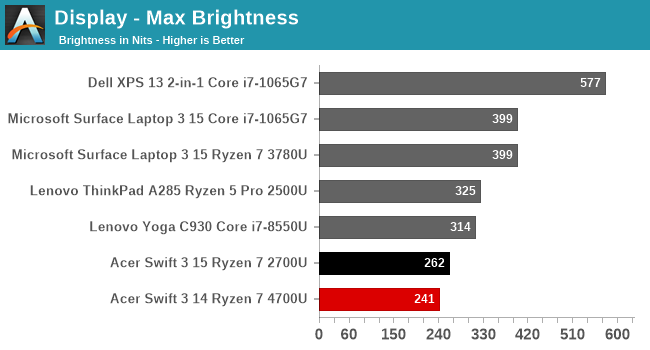
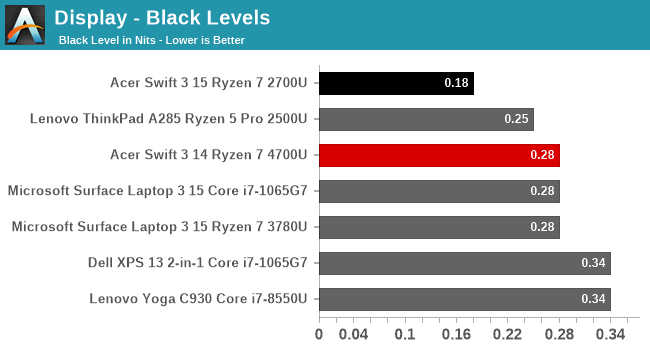
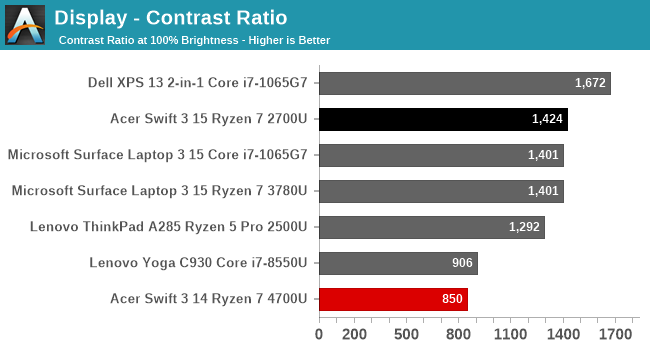
The Acer Swift 3 does not get off to a great start. In a budget notebook, displays tend to be one of the first things on the chopping block. Luckily, we’ve moved past the era where these types of notebooks would offer 1366x768 TN panels, but Acer’s 1920x1080 IPS choice doesn’t offer very good black levels, and their backlight is somewhat weak. It is an inauspicious start.
Grayscale

Grayscale measures the laptops ability to display white levels, from 0% (black) to 100% (white), and the Swift 3 performs quite poorly here. The blue levels are far too strong across most of the range. Gamma is also way off of the expected 2.2 level.
Gamut
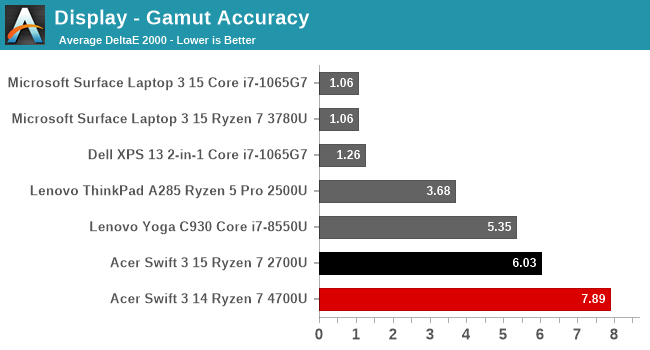
Windows 10 is still an sRGB system first and foremost, so proper sRGB gamut support is required for proper color accuracy. The Acer Swift 3 unfortunately does not cover anywhere near the sRGB gamut, which means that the LED backlighting was likely another area where some money was saved. Although grayscale can be salvaged with some ICC profiles, without full sRGB backlighting this laptop would likely suffer further if an ICC was applied because it simply cannot cover the entire sRGB spectrum.
Saturation
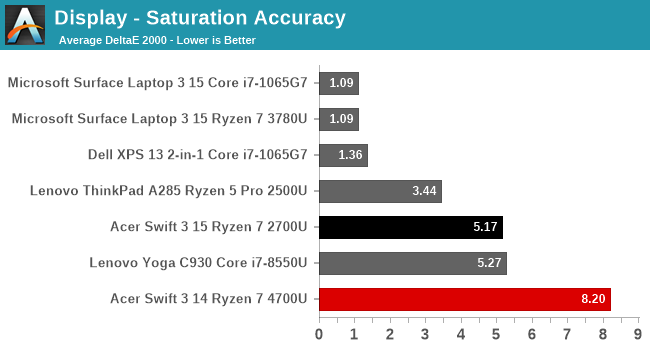
The saturation test covers the primary and secondary colors, but unlike the gamut where they are just measured at 100% level, we test them on 4-bit steps from 0% to 100%. Since we’ve already determined the laptop can’t hit the full sRGB gamut, it is no surprise to see the saturation sweeps suffer.
Gretag Macbeth
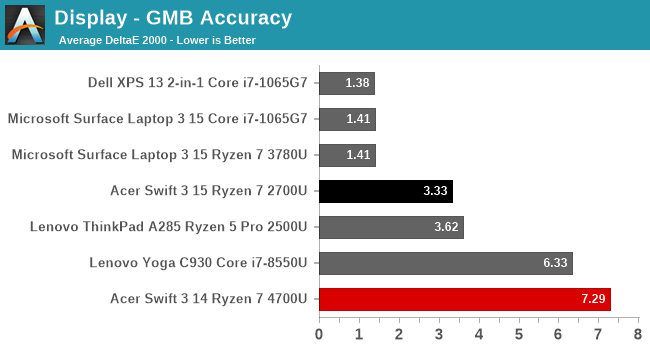
The Gretag Macbeth tests colors off of the primary and secondary axis, including the important skin tones, but with a display that can’t reproduce the entire sRGB range, the Acer Swift 3 naturally performs quite poorly on this test.
Colorchecker
Finally, we have the colorchecker, where you can more easily visualize the color errors with this display. This is a relative test, since any errors in your own display will influence the result, but on the bottom of the swatches is the color requested, and the top shows the color produced by the display. It is not pretty.
Display Conclusion
Overall, despite the poor showing here, the display is in-line with expectations at this price point. Over the last couple of years, there has been a push for better displays, and laptop makers have made the jump to 1920x1080 IPS panels pretty much across the board; so even though this display is poor compared to better IPS-based laptops, it still does offer the good viewing angles an IPS panel enjoys, and 1920x1080 works very well on a 14-inch screen size.
The very poor backlighting really does hamper the capabilities of this notebook. If you wanted to use it for editing photos or video, the internal components like the CPU, memory, and GPU, really would help, but the included display with its lack of sRGB coverage would certainly hinder the work. For basic office tasks, or even gaming, most people who are looking at a laptop at this price point will likely not be too concerned about the display, but just be aware that this one is deficient in several areas.


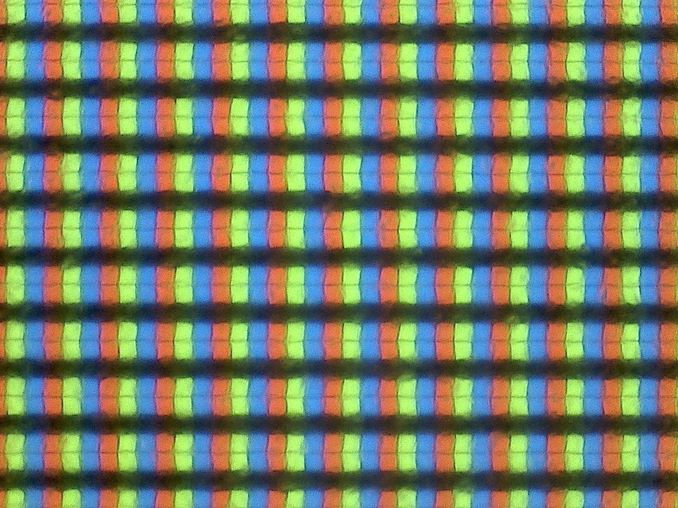













191 Comments
View All Comments
Samus - Tuesday, May 5, 2020 - link
Wow.watzupken - Tuesday, May 5, 2020 - link
Not sure if anyone pointed out as a feedback, but the legend and the numbers on the axis on the thermal related graphs are too small to see.Anyway, I actually don't find it surprising the performance is once again held back by poor cooling. Considering this is a 1.2KG 14 inch laptop, it should not come across as surprising. We need to consider the fact that this is a proper 8 core processor with a fast GPU. While light is good, but I feel we have gone passed a reasonable/ sensible pushed for slimmer and ligher laptops. Slimmer/ lighter generally means compromising on battery, and/or, cooling.
Brett Howse - Wednesday, May 6, 2020 - link
You can click on the image to get a full-sized version of the thermal graphswatzupken - Wednesday, May 6, 2020 - link
Yeah, I figured out later, but unable to amend my post. Perhaps you folks should consider putting in an edit button here.neblogai - Wednesday, May 6, 2020 - link
There may be an issue with the sample Anandtech got. Cooling is generally praised in other reviews of the same laptop, it does not go over 70C at sustained loads (18W). Also, here is FarCry5 running perfectly fine of Swift3 (4500U, but same at the same 18W): https://youtu.be/TvVaJ5jlgsQHowever, if you look at the graphs Anandtech posted- especially the first graph is telling: at 18W, temps go up slowly from ~65C to ~70C, but then suddenly jump to ~95C, with a hard throttle as a result. Something is failing in their unit, a properly functioning cooling would not be behaving like this.
SkillTim - Wednesday, May 6, 2020 - link
Can someone explain:According to Wikipedia, the 4700U iGPU gives 1433.6 GFLOPS raw performance and the 3780U iGPU gives 1971.2 GFLOPS. Why does this review seem to give the 4700U the win every time in real world performance? Is the review selective? Is Wikipedia wrong? Is the CPU/GPU I/O better in Zen 2?
neblogai - Wednesday, May 6, 2020 - link
1. TFPLOPs is just one paramether- Renoir has higher bandwidth, 2x IF width with iGPU, higher Pixel rate, etc.2. Those Picasso TFLOPs in Wiki, and in AMD slides, are theoretical/marketing speeds, not real life ones. Picasso can not run games at that clock/those TFLOPs, as there is not enough power for it. While Renoir/ is mostly able to keep it's boost/TFLOPs (at least in CPU/light games).
Peskarik - Wednesday, May 6, 2020 - link
Good monitor and bigger battery for 100g more weight and 300 more cost would be welcomed.watzupken - Wednesday, May 6, 2020 - link
If you are looking for better monitor and longer battery life, I think you will need to move up to the Swift 5 series. I observed that Acer have been using very dim monitors (250 nits or lower) on their Swift 3 series for a number of years now and I doubt they will give you a better option to maintain the product segmentation.Peskarik - Wednesday, May 6, 2020 - link
thanks, watzupken